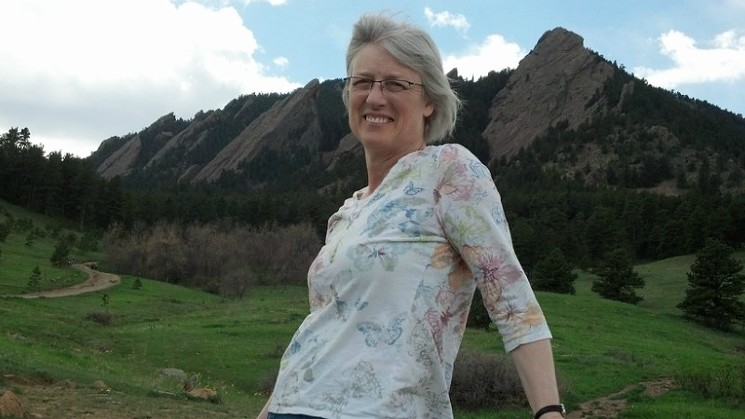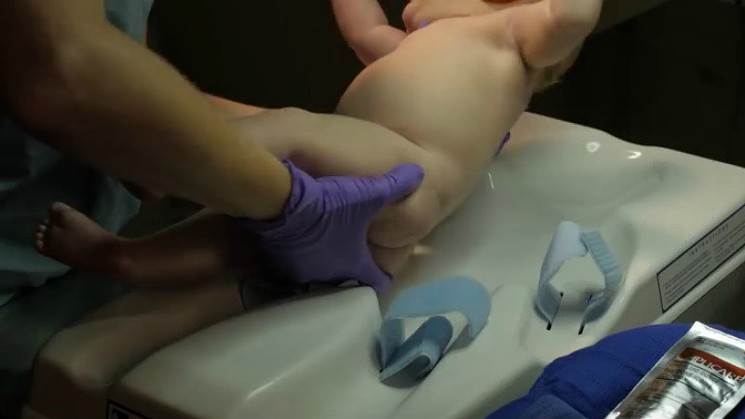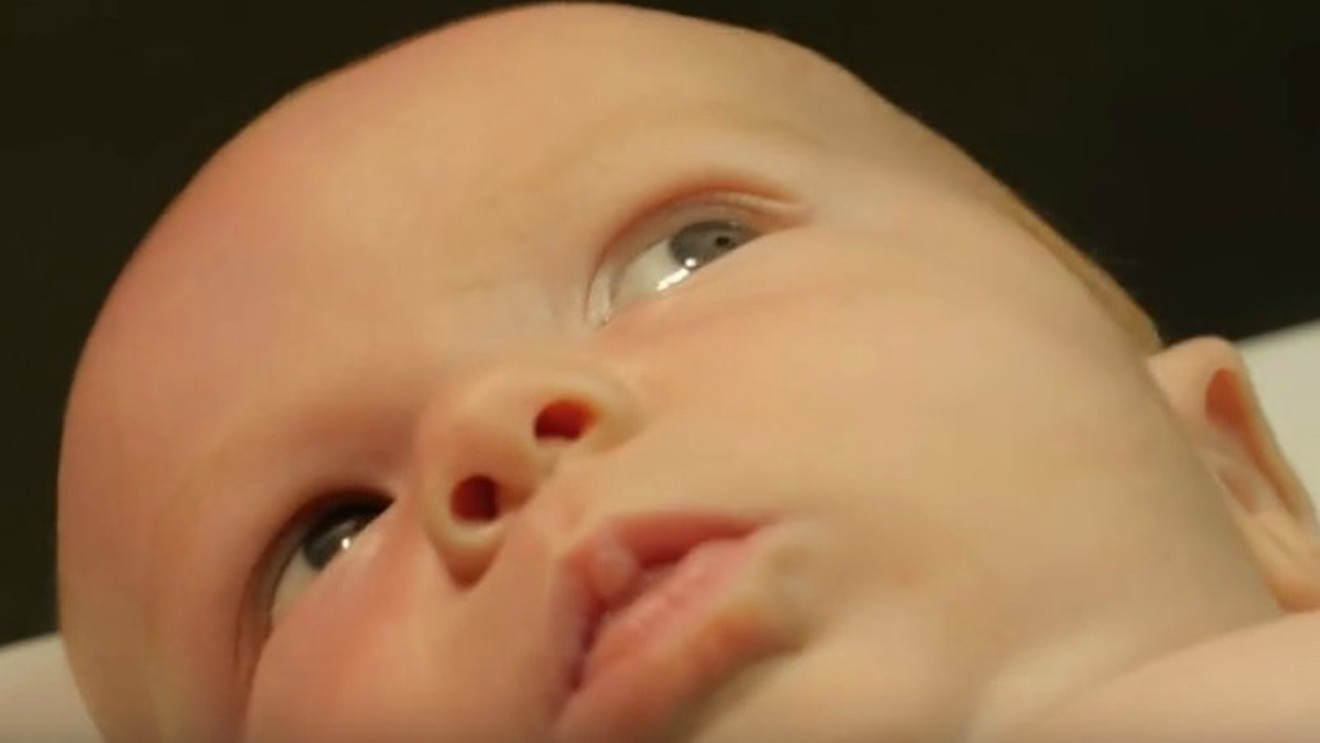"Mainly the work is about opening people's eyes about how circumcisions are done, what the babies go through and what the risks are," Longley says. "There are a whole range of complications, some common but low grade, others not very common but extremely serious — like losing the whole shaft of the penis or even death. These things happen."
A trailer for American Circumcision is shared here, along with a quiz designed to test your "foreskin IQ."
The precursor to Colorado ABC was Colorado NOCIRC (National Organization of Circumcision Information Resource Centers). "Colorado NOCIRC has been around in some form or another for decades," Longley points out. "The national organization was founded in 1985 by Marilyn Milos, a nurse who found out about circumcision the hard way in nursing school, after she'd had it done for her own children. A doctor told her there was no medical reason for doing this, and her jaw dropped. After that, her whole mission became trying to end circumcision."

Gillian Longley is the state coordinator for the Colorado Advocates for Body Integrity and Children's Rights.
Facebook
Longley got involved with Colorado NOCIRC in 2005. "As a nurse, I was looking for my own form of support, because I was working in a nursery and had to be around circumcision," she recalls. "I had decided this wasn't a good thing to do, and so I got involved. We organized to the point where we were meeting regularly and getting involved in all kinds of projects. We've done booths at fairs and conferences, and we got involved with legislative issues, such as trying to get Colorado Medicaid not to pay for circumcisions."
Representative Mark Larson, a Republican from Cortez, became the point person for removing circumcision from Colorado Medicaid funding.
"Federal law says Medicaid is only supposed to be used for medically necessary procedures, and that doesn't apply to circumcision or any other elective or cosmetic procedure," Longley allows. "But it's such a culturally embedded procedure that we ended up going back and forth, back and forth with it in the legislature. It was taken out of the budget at one point, and then opponents tried to make it a law that it had to be paid for. We testified against that, and it didn't get put back in."
As a result of such efforts, "circumcision wasn't paid for from 2011 to 2017 in Colorado," Longley says. "But in 2017, it was put back in by amendment, so we're sort of back where we started from with that." Efforts to once again block Colorado Medicaid funding for circumcision were put on the back burner this year in part because, with Larson no longer in office, the group lacked an advocate. But Colorado ABC supporters are actively looking for a legislator to spearhead the issue again in coming years.
Meanwhile, Colorado NOCIRC has rebranded. "We've been shifting to genital autonomy — the idea that you get to decide what you do with your own genitals surgically or otherwise," Longley reveals. "And at the same time, Marilyn Milos is getting older, and with multiple other groups on the Internet working for genital autonomy [examples include DoctorsOpposingCircumcision.org and YourWholeBaby.org], she was like, 'Okay, I'm done with my phase. We'll let these other organizations take over and lead the charge.'"

This image from the documentary American Circumcision shows an apparatus to which male babies are strapped prior to being circumcised.
The next few months promise to be busy for Longley and company. "We're going to exhibit at the People's Fair in Denver, the Colorado Springs PrideFest, a baby fair in the fall and the Association for Prenatal and Perinatal Psychology and Health conference that's going to be in Denver in October."
And then there's American Circumcision, which is rolling out by way of screenings across the country. "People in the movement feel it's a game-changer when it comes to educating the public," says Longley, who'll speak after the local screening about being what she calls "a conscientious objector to circumcision. Working in a nursery, you can imagine that there was a little bit of friction — like, 'What do you mean, you're not going to help the doctor with that?' I had to be my own advocate, and there weren't many people around who could understand what my concerns were. There's still so much ignorance and complacency around this issue. But we're working hard to make a change."
The screening of American Circumcision takes place at 7 p.m. Monday, April 9, at the Sie FilmCenter, 2510 East Colfax Avenue. Longley is scheduled to take part in the post-movie Q&A alongside filmmaker Brendon Marotta. Click for more information. Below, see the trailer for the documentary, followed by the aforementioned foreskin IQ quiz.
What Is Your Foreskin IQ?
1. The surface area of a normal adult foreskin is:
a. 2 square inches (13 cm2) — about the size of a silver dollar.
b. 5 square inches (32 cm2) — about the size of a matchbook cover.
c. 10 square inches (64 cm2) — about the size of a common Post-it note.
d. 15 square inches (95 cm2) — about the size of an index card.
2. The most sensitive portion of the penis is the:
a. glans.
b. corpus dictum.
c. C-spot.
d. frenulum/ridged band.
e. foreskin “lips” (distal prepuce).
3. The foreskin serves to:
a. provide sexual pleasure.
b. provide the skin necessary to accommodate a full erection.
c. cover and protect the urinary opening.
d. none of the above
e. a, b, and c
4. The average age when a boy’s foreskin is fully retractable is:
a. birth.
b. 6 months.
c. 1 year.
d. 5 years.
e. 10 years.
5. Circumcision became popular in the early part of the last century to prevent:
a. masturbation.
b. epilepsy.
c. insanity.
d. paralysis.
e. all of the above
6. Circumcision has been proven to cost-effectively prevent:
a. cervical cancer.
b. penile cancer.
c. bladder infection.
d. HIV/AIDS.
e. all of the above
f. none of the above
7. A circumcised penis is, on average,:
a. the same length as an intact penis.
b. longer than an intact penis by 1/3" (8 mm).
c. shorter than an intact penis by 1/3" (8 mm).
8. Infant circumcision is:
a. medically recommended.
b. safe and painless.
c. proven to protect against many medical conditions.
d. all of the above
e. none of the above
9. Circumcised men have:
a. the same sexual sensitivity as intact men.
b. 25% greater sexual sensitivity than intact men.
c. 75% less sexual sensitivity than intact men.
10. Match the percentage of boys being circumcised at birth with their country:
___ about 60%
___ about 10%
___ about 1%
a. Britain
b. United States
c. Canada
11. The number of US adolescent boys mistaken about, or not knowing, their circumcision status is:
a. none.
b. 10%.
c. 20%.
d. 30%.
12. Jewish ritual circumcision (bris or brit milah):
a. is mandated by Genesis 17, with the procedure remaining unchanged to the present time.
b. is required to establish a male’s Jewish identity.
c. when substituted with a hospital surgical circumcision, meets the requirements of Jewish law.
d. all of the above
e. none of the above
Answers: The last choice is correct for all but #10, which is: b, c, a.












